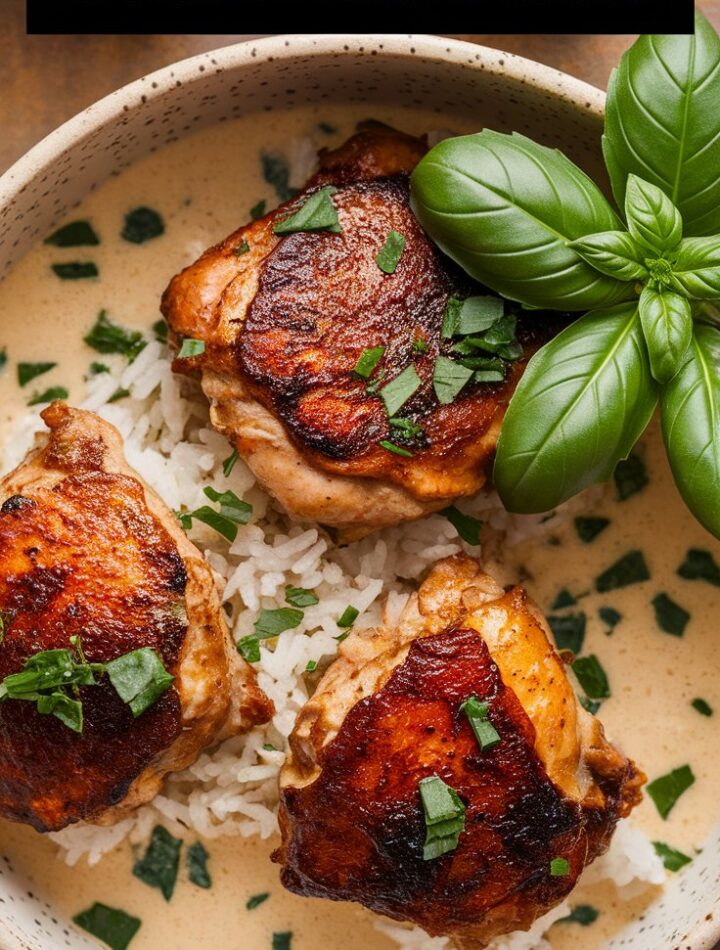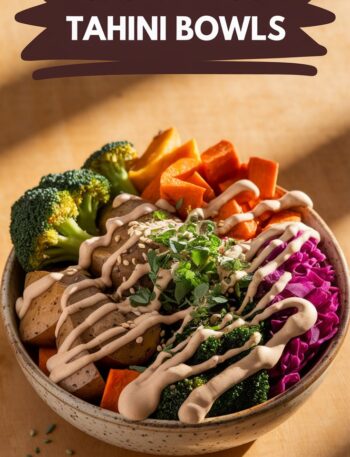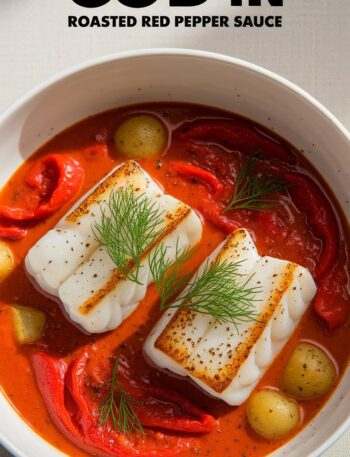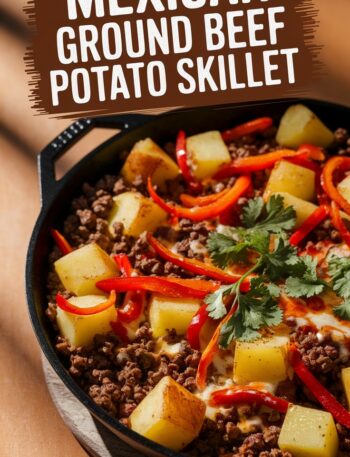If there’s one dish that can instantly transform your dinner table into an aromatic paradise, it’s Basil Chicken in Coconut Curry Sauce. This creamy, fragrant, and flavor-packed recipe beautifully balances the warmth of curry spices, the sweetness of coconut milk, and the refreshing brightness of fresh basil.
Whether you’re craving something exotic yet easy to prepare, or looking for a comforting, restaurant-quality dinner that’s ready in under 40 minutes, this recipe has you covered. It’s a wholesome combination of tender chicken simmered in velvety coconut curry sauce — a perfect fusion of Thai and home-style cooking that everyone will fall in love with.
Let’s dive into the rich story, ingredients, and steps that make this Basil Chicken Coconut Curry a meal worth repeating week after week.
Why You’ll Love This Recipe
- Bursting with Flavor: Every bite brings a delicious mix of sweet, savory, and mildly spicy notes enhanced by coconut milk and fresh basil.
- Simple and Quick: Ready in less than 40 minutes — ideal for busy nights when you still want something special.
- Customizable: You can adjust the spice level, switch proteins, or make it vegetarian without losing the flavor magic.
- Healthy Comfort Food: Made with real ingredients — lean chicken, coconut milk, and herbs — it’s naturally gluten-free and nourishing.
- Perfect for Any Occasion: Serve it as a cozy family dinner, or dress it up with fragrant jasmine rice for an impressive weekend meal.
A Little Background on Coconut Curry and Basil
Coconut curry is a culinary gem found throughout Southeast Asia — particularly in Thailand, Malaysia, and Indonesia — where creamy coconut milk serves as the foundation for countless beloved dishes. The delicate sweetness of coconut perfectly balances the fiery heat of curry paste or powder, creating a sauce that’s both comforting and exotic.
Basil, on the other hand, adds a fresh, herbal dimension. In Thai cuisine, holy basil (kaprao) or Thai basil is commonly used for its slightly peppery and anise-like aroma. When combined with coconut curry, basil transforms the dish into something deeply aromatic and satisfying — a perfect example of balance and harmony in flavor.
This version of Basil Chicken in Coconut Curry Sauce captures that same harmony in a simple home-friendly format — no hard-to-find ingredients, just pure, vibrant taste.
Ingredients You’ll Need
Here’s what makes this dish shine. Every ingredient plays an important role in building depth, creaminess, and freshness.
Main Ingredients:
- 1 lb (450g) boneless, skinless chicken thighs or breasts – tender and juicy, perfect for soaking up curry flavor.
- 1 tbsp vegetable or coconut oil – adds richness and helps sear the chicken.
- 1 medium onion, finely chopped – builds sweetness and body into the sauce.
- 3 cloves garlic, minced – essential aromatic base.
- 1 tbsp fresh ginger, grated – adds warmth and depth.
- 2 tbsp red or yellow curry paste – the heart of the curry flavor.
- 1 can (400ml / 14 oz) full-fat coconut milk – creamy and silky base for the sauce.
- 1 tbsp fish sauce or soy sauce – brings umami and salt balance.
- 1 tsp brown sugar or palm sugar – balances the salt and spice.
- 1 tbsp lime juice – fresh acidity that brightens the whole dish.
- 1 cup fresh basil leaves – Thai basil preferred, but sweet basil works too.
- 1 red bell pepper, thinly sliced (optional) – for a pop of color and crunch.
Optional Garnishes:
- Chopped cilantro
- Lime wedges
- Crushed peanuts or cashews
- Steamed jasmine rice or rice noodles
Step-by-Step Instructions
Step 1: Prepare the Ingredients
Before you start cooking, prep everything. Slice the chicken into bite-sized pieces, mince the garlic, grate the ginger, and chop the onion. Wash and dry the basil leaves gently. Having your ingredients ready makes cooking fast and seamless.
Step 2: Sauté the Aromatics
In a large skillet or wok, heat the oil over medium heat. Add the chopped onions and sauté for 2–3 minutes until soft and translucent. Add minced garlic and grated ginger, stirring constantly until fragrant — about 30 seconds to 1 minute. This base will infuse the sauce with deep, aromatic flavor.
Step 3: Add the Curry Paste
Stir in the red curry paste and cook for 1–2 minutes. Heating it briefly helps release the spices and oils, which are essential for a rich-tasting curry. If you prefer a milder curry, start with 1 tablespoon; for a spicier dish, use 2–3 tablespoons.
Step 4: Brown the Chicken
Add the chicken pieces to the skillet. Sear for 4–5 minutes, stirring occasionally, until the chicken is lightly browned on all sides. It doesn’t need to be fully cooked yet — just enough to lock in flavor.
Step 5: Add the Coconut Milk
Pour in the coconut milk and stir well to combine. Scrape up any bits stuck to the bottom of the pan for extra flavor. Bring the sauce to a gentle simmer.
Step 6: Season the Sauce
Add the fish sauce (or soy sauce), brown sugar, and lime juice. Taste and adjust to your liking — add more lime juice for tanginess or a pinch more sugar if the sauce feels too salty or spicy.
Let it simmer uncovered for 10–15 minutes, stirring occasionally, until the chicken is fully cooked and the sauce thickens slightly.
Step 7: Add the Basil
Turn off the heat and stir in fresh basil leaves. The residual warmth will gently wilt the leaves, releasing their aroma without losing color or freshness.
Step 8: Serve and Enjoy
Serve hot over steamed jasmine rice or rice noodles. Garnish with chopped cilantro, a squeeze of lime, or crushed peanuts for added crunch.
Pro Tips for the Best Basil Chicken Curry
- Use Full-Fat Coconut Milk:
Light coconut milk can make the sauce watery. Full-fat coconut milk delivers a velvety, restaurant-quality texture. - Don’t Overcook the Basil:
Add basil at the very end. Prolonged heat can make it lose flavor and turn dark. - Balance the Flavors:
A perfect curry is about balance — spicy, salty, sweet, and tangy. Adjust these elements according to your taste. - Customize the Spice Level:
- Mild: Use yellow curry paste.
- Medium: Use red curry paste with ½ chili.
- Hot: Use 2 tbsp red curry paste + 1 fresh chili.
- Make It Creamier:
Stir in a spoonful of coconut cream or cashew butter at the end for extra richness. - Cook in a Wok or Deep Skillet:
The wider base helps ingredients cook evenly and the sauce reduce beautifully.
Flavor Variations
One of the best parts about this recipe is its flexibility. Here are some creative twists to make it uniquely yours.
1. Vegetarian or Vegan Version
Replace chicken with firm tofu or mixed vegetables like bell peppers, snap peas, mushrooms, and zucchini. Use soy sauce instead of fish sauce. The result is a hearty, plant-based curry full of flavor.
2. Peanut Coconut Curry
Add 2 tablespoons of creamy peanut butter while simmering the sauce for a nutty depth that complements the coconut perfectly.
3. Pineapple Curry Chicken
Stir in a handful of pineapple chunks before simmering. The fruity sweetness contrasts beautifully with the spicy curry and creamy sauce.
4. Thai-Inspired Basil Curry
Add Thai basil and kaffir lime leaves for a more authentic Southeast Asian flavor. A splash of coconut cream and a pinch of chili flakes take it to another level.
5. Basil Shrimp Curry
Swap chicken for shrimp — cook them briefly (about 3–4 minutes) so they stay juicy and tender.
Serving Suggestions
This curry is wonderfully versatile. Try pairing it with:
- Steamed Jasmine Rice – classic pairing that soaks up every bit of sauce.
- Brown Rice or Quinoa – a wholesome, fiber-rich alternative.
- Coconut Rice – for a tropical twist.
- Rice Noodles or Vermicelli – makes for a light, noodle-style bowl.
- Flatbread or Garlic Naan – perfect for dipping into the creamy sauce.
You can also top it with fresh lime wedges, extra basil, and chopped peanuts for a restaurant-style presentation.
Storage and Reheating
- Refrigerate: Store leftovers in an airtight container for up to 3 days.
- Freeze: Freeze up to 2 months. Thaw overnight in the refrigerator before reheating.
- Reheat: Warm gently in a skillet over low heat. Add a splash of coconut milk or water if the sauce thickens too much.
Avoid microwaving repeatedly, as it can dull the basil flavor and make the chicken rubbery.
Make-Ahead Tips
This dish actually tastes even better the next day, as the flavors deepen overnight.
To meal prep:
- Cook the curry sauce and chicken fully.
- Store the sauce separately from rice or noodles.
- Combine and reheat before serving.
It’s perfect for busy weeks, office lunches, or family dinners that need to be ready in minutes.
Nutritional Information (Per Serving)
(Approximate values — may vary by ingredients used)
- Calories: 430
- Protein: 32g
- Carbohydrates: 12g
- Fat: 28g
- Fiber: 2g
- Sugar: 5g
This makes it a balanced meal — high in protein, moderate in carbs, and rich in healthy fats from coconut milk.
Common FAQs
1. Can I use chicken breasts instead of thighs?
Yes. Chicken breasts work fine, but they cook faster and can dry out. Watch the timing closely and don’t over-simmer.
2. What can I use instead of coconut milk?
For dairy-free alternatives, use almond milk or oat milk thickened with a spoonful of cashew cream. It won’t taste exactly the same but remains delicious.
3. How do I make it less spicy?
Use mild curry paste, reduce the amount of chili, and add extra coconut milk to mellow the heat.
4. Can I make this curry gluten-free?
Yes! Use gluten-free soy sauce or tamari, and make sure your curry paste doesn’t contain wheat or additives.
5. What’s the difference between Thai basil and regular basil?
Thai basil has a spicier, licorice-like flavor, while sweet basil is softer and sweeter. Either works in this dish, but Thai basil adds authentic flair.
6. Can I use store-bought curry paste?
Absolutely. Just make sure to check the label for natural ingredients and no preservatives for best results.
7. How can I thicken the sauce naturally?
Let it simmer uncovered for a few extra minutes. Or mix 1 tsp cornstarch with 2 tbsp water, then stir it in toward the end.
8. Can I make it dairy-free and nut-free?
Yes — the recipe is naturally dairy-free. Skip the peanut variation if avoiding nuts.
9. What sides go best with this curry?
Try cucumber salad, coconut rice, or simple sautéed veggies like broccoli or bok choy.
10. Can I add vegetables to this curry?
Definitely. Bell peppers, spinach, carrots, or snow peas add color and texture. Add them during the last 5 minutes of simmering to keep them crisp.
Expert Tips for Perfect Curry Every Time
- Prep Everything First: Curries move quickly once started. Have all ingredients chopped and ready.
- Control Heat: Medium heat allows ingredients to cook evenly without burning aromatics.
- Layer Flavors: Sauté onion, garlic, and ginger before adding paste — this layering creates restaurant-level depth.
- Taste as You Go: Adjust salt, sugar, and lime juice to match your palate.
- Rest Before Serving: Let curry rest for 5 minutes before serving to allow the flavors to settle.
Cultural Inspiration
While this dish is inspired by Thai cuisine, it’s not limited to one region. The use of basil and coconut milk symbolizes balance in Asian cooking — where heat, sweetness, and freshness coexist in harmony.
In Thai households, coconut curry is comfort food. Families gather around steaming bowls of fragrant curry, served with rice and laughter. That sense of warmth and simplicity is exactly what this recipe brings to your table — a meal made for sharing and savoring.
Pairing Ideas
If you’re hosting dinner or want to create a complete meal experience, try pairing your Basil Chicken in Coconut Curry Sauce with:
- Appetizer: Fresh spring rolls with peanut dipping sauce.
- Side: Thai cucumber salad or coconut jasmine rice.
- Drink: Iced Thai tea, coconut water, or white wine (Riesling).
- Dessert: Coconut mango sticky rice or pineapple coconut pudding.
Storage-Friendly Meal Prep Option
This recipe works perfectly for weekly meal prep.
- Make a large batch of curry on Sunday.
- Store individual portions in containers with rice.
- Reheat and garnish with fresh basil before serving.
The flavors remain vibrant and the sauce keeps the chicken moist even after reheating.
Troubleshooting Common Mistakes
- Sauce too thin? Simmer uncovered longer or add 1 tsp cornstarch mixed with water.
- Sauce too thick? Add a splash of coconut milk or water.
- Too spicy? Stir in extra coconut milk or a little sugar.
- Chicken dry? Use thighs instead of breasts next time; they stay juicier.
Conclusion
Basil Chicken in Coconut Curry Sauce is a perfect blend of comfort and excitement — creamy, spicy, and irresistibly aromatic. It captures the essence of Thai-inspired cooking while staying accessible and quick enough for weeknights.
Every spoonful carries the fragrance of fresh basil, the silkiness of coconut, and the satisfying savor of tender chicken. Serve it over jasmine rice, enjoy it with loved ones, and let this simple yet luxurious curry become one of your go-to recipes.




